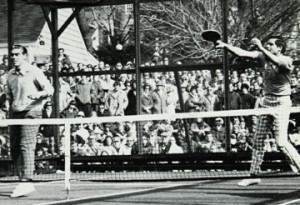Mangan, John F.
John Mangan was one of the top players of the game in the 1960s, 70s and early 1980s. A member of Manursing Island Club in Rye, NY, he first played paddle at the Fox Meadow Tennis Club when he was still playing indoor tennis tournaments. With partner Bob Kingsbury, he won the Men’s Nationals in 1972 and 1973, and was a finalist in 1970-1971, and 1975. With Kingsbury, John also had the distinction of winning the first prize money tournament ever, held in 1973 at the Sea Pines Resort in Hilton Head, SC; and, in 1974, winning, in Amelia Island, FL, the first nationally-televised tournament, carried by CBS’ Sports Spectacular. The duo won every tournament on the circuit, at least once—three times in the case of the Cleveland Invitational—except at Short Hills. Mangan later wiped out that exception by winning at Short Hills with Tommy Holmes. John reached the Men’s Nationals semi-finals eight times, five times with Kingsbury, and once each with Ted Winpenny, Gordon Gray and John Adams. In the semi-final with Winpenny, they were leading two sets to one when Winpenny was informed his father has just died and they had to default. John also won the Mixed Nationals in 1970 with Susie Harris, and was a finalist with Gloria Dillenbeck in 1974 and 1975. In 1980, and somewhat past his prime, at the age of 44, John won the Indoor Men’s Nationals with John Adams against a strong field, defeating the three top nationally ranked teams. He also served as an APTA Board member from 1974-1976.
Mangan was a fine all-around athlete who was twice selected to All-Philadelphia City High School in Basketball, and once in Football, and was elected to the Haverford School Hall of Fame in 2010. He also was ranked number two in Junior (under 18) tennis by the Middle States Tennis Association. He had an outstanding college tennis career at the University of Pennsylvania, where he was captain and played number one doubles and singles for three years, as well as two years of varsity basketball as a starting forward. In tennis competition, he played at Forest Hills in the U.S. Open Tennis Championships seven times, was ranked by the USTA in the top 53 in Men’s Singles twice (1964-1965), and won the Bermuda Championships, singles and doubles, in 1963 and 1970. He also won the U.S. National Father and Son Clay Court Championship in 1979, was a finalist three consecutive times in the Father and Son Grass Court Championship from 1978 to 1980, and was ranked number one in 1979 and in the top ten for eight years with three different sons. Later in his tennis career, he won the California State Senior Singles in the 45+ division twice, in 1981 and 1982. and once in the 50+ division in 1986.
It was fellow Hall of Famer Zan Carver, a former tennis partner, who introduced Mangan to paddle. After a year of “social” paddle, Zan teamed John with Kingsbury because he felt strongly that their games would compliment each other, as did Zan and Dick Hebard when they won the Men’s Nationals. One memorable match during his time with Carver had them playing in the Rye Invitational. In their fourth match of the day, Carver fell and twisted his ankle badly. They won that match but lost the next one to Dick Squires and Tommy Holmes in a long three-setter. After the loss Zan went to get his ankle injury diagnosed. It was broken.
John’s trademark shot, a heavy, top-spin forehand, was arguably one of the best offensive weapons in the history of the game. As his partner commented, “Herbie (Fitz Gibbon) probably had the best return of the era, in a class with Gordie Gray, but John Mangan had the heaviest return ever. Just ask those who faced it. For that reason John’s forehand was the biggest offensive weapon in the game in the 1970s. Period.” His confidence in all situations, in any event, in any arena, whether ahead or behind, was the same—total belief that he could hit that forehand past, between or right through any team out there.
While extremely competitive, beneath the surface John was an outstanding sportsman and a true gentleman on the court. He was a strong ambassador for the game, playing countless exhibitions all over North America.
After John graduated from the University of Pennsylvania in 1960, he worked in the officer-training program at Irving Trust Company on Wall Street, while going to night school at NYU’s Graduate Stern School of Business. After graduating, he clerked on the floor of the New York Stock Exchange, becoming an owner of a NYSE membership in 1964, and a partner at Pershing & Company from 1968-1977. He was the Managing General Partner of the venture capital firm Rose Investment Company from 1978-1986, and President and CEO of Prudential Bache Capital Partners from 1986-1992.




